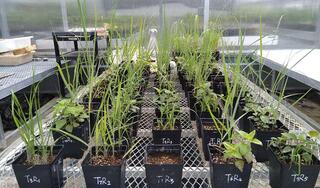When it comes to soil carbon storage, a plant’s neighbors can make all the difference

Some Midwest prairie perennials, including the bioenergy crop switchgrass, can increase soil carbon when grown near other plant species.
The Science
Plants pull carbon dioxide from the air and deposit it as organic compounds into the soil. The crops that do it most effectively can keep agricultural lands healthy and productive while reducing the negative impacts of farming on climate change. Diverse plant communities are known to boost carbon storage in the soil. Now, a key discovery by Great Lakes Bioenergy Research Center (GLBRC) scientists reveals how root interactions among Midwest prairie perennials, including the bioenergy crop switchgrass, increase soil carbon when grown in specific pairings. These beneficial plant combinations also created more soil pores that support fungi that are associated with soil carbon accrual.
The Impact
These results suggest that carbon transfer between species may drive the higher soil carbon storage seen in diverse plant communities. They may also explain why carbon accrual benefits attributed to switchgrass in mixed communities haven’t held up when switchgrass is planted alone, despite its deep root systems. Knowing that certain species fix more carbon underground when placed side-by-side could allow farmers to design cropping and grazing systems that more effectively move carbon from the air to the soil.
Summary
Boosting plant-driven carbon storage in soils is one strategy for mitigating climate change. Although it is clear that diverse plantings store more carbon, some studies link carbon gains with greater species diversity while others highlight the presence of a key species, such as deep-rooted grasses or nitrogen-fixing legumes. In this study, GLBRC scientists planted switchgrass, big bluestem, and wild bergamot alone and in different pairings and measured interplant carbon transfer and storage in the soil.
The team used a stable isotope labeling approach to track carbon’s flow through the environment and between plants. The researchers discovered that certain pairs of plants, including switchgrass with both big bluestem and bergamot, transferred more carbon in their plant roots to each other and into in the ground. Larger soil pores, a sign of good soil microbe health, were also found in cases of greater carbon transfer between plants. These results explain why previous studies have shown both plant diversity and the presence of certain species are important in storing carbon in bioenergy cropping systems, on lands not otherwise suitable for food crops, and in native prairie restoration areas. This information can help farmers and researchers design plantings that build healthier soils while addressing a key driver of climate change.
Program Manager
N. Kent Peters
Program Manager, Office of Biological and Environmental Research
kent.peters@science.doe.gov, 301-903-5549
Corresponding Authors
Alexandra Kravchenko
Professor, Michigan State University
kravche1@msu.edu, 517-353-0469
Andrey Guber
Assistant Professor, Michigan State University
akguber@msu.edu, (517) 353-0269
Publication
Kravchenko, A.N., Zheng, H., Kuzyakov, Y., Robertson, G. P., and Guber, A.K., “Belowground interplant carbon transfer promotes soil carbon gains in diverse plant communities.” Soil Biology and Biogeochemistry 159, 108297 (2021) [DOI: 10.1016/j.soilbio.2021.108297]